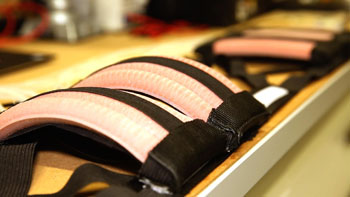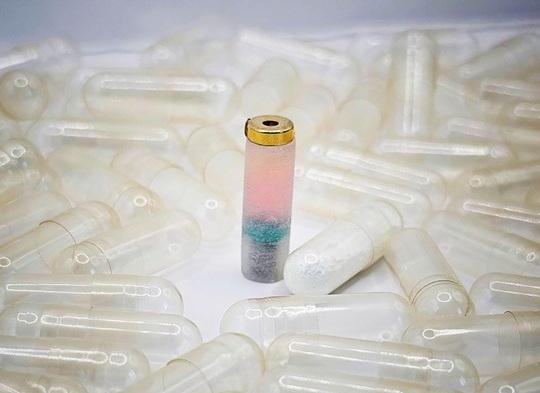Soft Robotics Mimic Human Muscle Function
|
By HospiMedica International staff writers Posted on 27 Oct 2016 |

Image: Soft robots can be spatially manipulated using air pressure (Photo courtesy of EPFL).
Innovative reconfigurable robots powered by muscle-like actuators could be used in assistive wearable devices for physical rehabilitation.
Under development at Ecole Polytechnique Fédérale de Lausanne (EPFL; Switzerland), the actuator prototypes include both linear and bending actuators with varying geometric parameters that can be used in diverse soft robotic systems for a wide set of assistive wearable technologies, including replicating the motion of several parts of the human body. The soft robots are made of elastomers such as silicon and rubber, and are controlled by changing air pressure in specially designed compartments, or modules, which also serve as the robot’s body.
The cucumber-shaped actuators can stretch up to around five or six times their normal length and bend in two directions, depending on the model. The soft robots are designed for use on the human body, with potential implementations including a wide variety of bioinspired and biomimetic systems, such as devices to assist gripping and manipulation of fragile objects. For example, one of the designs is a belt made of several inflatable components, which holds patients upright during rehabilitation exercises and guides their movements. A study describing the soft robotics was published on September 27, 2016, in Nature - Scientific Reports.
“Our robot designs focus largely on safety. There’s very little risk of getting hurt if you're wearing an exoskeleton made up of soft materials, for example,” said Professor Jamie Paik, PhD, director of the EPFL Reconfigurable Robotics Lab (RRL). “Using soft actuators, we can come up with robots of various shapes that can move around in diverse environments. They are made of inexpensive materials, and so they could easily be produced on a large scale. This will open new doors in the field of robotics.”
“We conducted numerous simulations and developed a model for predicting how the actuators deform as a function of their shape, thickness, and the materials they’re made of,” said lead author Gunjan Agarwal, PhD. “Elastomer structures are highly resilient but difficult to control. We need to be able to predict how, and in which direction, they deform. And because these soft robots are easy to produce but difficult to model, our step-by-step design tools are now available online for roboticists and students.”
Related Links:
Ecole Polytechnique Fédérale de Lausanne
Under development at Ecole Polytechnique Fédérale de Lausanne (EPFL; Switzerland), the actuator prototypes include both linear and bending actuators with varying geometric parameters that can be used in diverse soft robotic systems for a wide set of assistive wearable technologies, including replicating the motion of several parts of the human body. The soft robots are made of elastomers such as silicon and rubber, and are controlled by changing air pressure in specially designed compartments, or modules, which also serve as the robot’s body.
The cucumber-shaped actuators can stretch up to around five or six times their normal length and bend in two directions, depending on the model. The soft robots are designed for use on the human body, with potential implementations including a wide variety of bioinspired and biomimetic systems, such as devices to assist gripping and manipulation of fragile objects. For example, one of the designs is a belt made of several inflatable components, which holds patients upright during rehabilitation exercises and guides their movements. A study describing the soft robotics was published on September 27, 2016, in Nature - Scientific Reports.
“Our robot designs focus largely on safety. There’s very little risk of getting hurt if you're wearing an exoskeleton made up of soft materials, for example,” said Professor Jamie Paik, PhD, director of the EPFL Reconfigurable Robotics Lab (RRL). “Using soft actuators, we can come up with robots of various shapes that can move around in diverse environments. They are made of inexpensive materials, and so they could easily be produced on a large scale. This will open new doors in the field of robotics.”
“We conducted numerous simulations and developed a model for predicting how the actuators deform as a function of their shape, thickness, and the materials they’re made of,” said lead author Gunjan Agarwal, PhD. “Elastomer structures are highly resilient but difficult to control. We need to be able to predict how, and in which direction, they deform. And because these soft robots are easy to produce but difficult to model, our step-by-step design tools are now available online for roboticists and students.”
Related Links:
Ecole Polytechnique Fédérale de Lausanne
Channels
Critical Care
view channel
AI Heart Attack Risk Assessment Tool Outperforms Existing Methods
For decades, doctors have relied on standardized scoring systems to assess patients with the most common type of heart attack—non-ST-elevation acute coronary syndrome (NSTE-ACS). The GRACE score, used... Read more
'Universal' Kidney to Match Any Blood Type
Blood-type incompatibility has long been one of the greatest obstacles in organ transplantation, forcing thousands of patients—particularly those with type O blood—to wait years longer for compatible donors.... Read moreSurgical Techniques
view channel
Minimally Invasive Endoscopic Surgery Improves Severe Stroke Outcomes
Intracerebral hemorrhage, a type of stroke caused by bleeding deep within the brain, remains one of the most challenging neurological emergencies to treat. Accounting for about 15% of all strokes, it carries... Read more
Novel Glue Prevents Complications After Breast Cancer Surgery
Seroma and prolonged lymphorrhea are among the most common complications following axillary lymphadenectomy in breast cancer patients. These postoperative issues can delay recovery and postpone the start... Read morePatient Care
view channel
Revolutionary Automatic IV-Line Flushing Device to Enhance Infusion Care
More than 80% of in-hospital patients receive intravenous (IV) therapy. Every dose of IV medicine delivered in a small volume (<250 mL) infusion bag should be followed by subsequent flushing to ensure... Read more
VR Training Tool Combats Contamination of Portable Medical Equipment
Healthcare-associated infections (HAIs) impact one in every 31 patients, cause nearly 100,000 deaths each year, and cost USD 28.4 billion in direct medical expenses. Notably, up to 75% of these infections... Read more
Portable Biosensor Platform to Reduce Hospital-Acquired Infections
Approximately 4 million patients in the European Union acquire healthcare-associated infections (HAIs) or nosocomial infections each year, with around 37,000 deaths directly resulting from these infections,... Read moreFirst-Of-Its-Kind Portable Germicidal Light Technology Disinfects High-Touch Clinical Surfaces in Seconds
Reducing healthcare-acquired infections (HAIs) remains a pressing issue within global healthcare systems. In the United States alone, 1.7 million patients contract HAIs annually, leading to approximately... Read moreBusiness
view channel
Philips and Masimo Partner to Advance Patient Monitoring Measurement Technologies
Royal Philips (Amsterdam, Netherlands) and Masimo (Irvine, California, USA) have renewed their multi-year strategic collaboration, combining Philips’ expertise in patient monitoring with Masimo’s noninvasive... Read more
B. Braun Acquires Digital Microsurgery Company True Digital Surgery
The high-end microsurgery market in neurosurgery, spine, and ENT is undergoing a significant transformation. Traditional analog microscopes are giving way to digital exoscopes, which provide improved visualization,... Read more
CMEF 2025 to Promote Holistic and High-Quality Development of Medical and Health Industry
The 92nd China International Medical Equipment Fair (CMEF 2025) Autumn Exhibition is scheduled to be held from September 26 to 29 at the China Import and Export Fair Complex (Canton Fair Complex) in Guangzhou.... Read more














